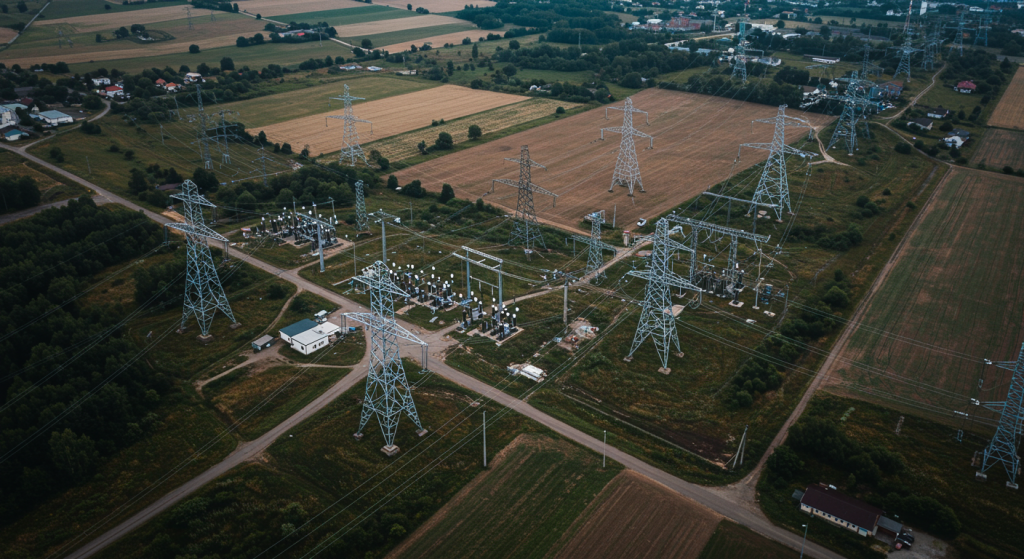Power Grid Infrastructure: From Generation to Your Home
2025-04-29
What is Power Grid Infrastructure?
- From the generation, transmission, and up to the distribution phases, users get electric power. The power grid infrastructure is a system of power plants, transmission, and distribution facilities that enables the powering of the users, and its components of a power plant is a system of power stations and lines, substations, and transformers.
- The entire infrastructure is encompassed and integrated with advanced computer-controlled monitoring and diagnosis systems as a whole. All these enable reliability of electric supply balance with system stability as devoiced control with various energy sources, including renewables from solar, wind, and hydropower, achieves strengthening for powering the users.
Preliminary Phase Critical Components of Power Grid Infrastructure Systems
- Power Lines:
These form a subclass of the Electric power Transmission Lines. The most defining characteristic of the lines is the distance long in Electricity Transmission. Power generation to the power plant reception point is simplified by constructing clearer routes for vessels and transport routes. Cross-boundary Energy Loss is controlled by elevating power at the plant and interfacing distribution substations. Power is reduced to lower voltages at the substation to enable commerce with households and businesses.
- Transformers: Power Transformers
They perform the voltage value increment about the output or input for both steps, up and down. Moreover, a charge or energy cannot be transferred due to a change in voltage, hence the need for a Block Transformer.
- Distribution and Transmission Infrastructure:
Together with the substations, the interconnected Power transmission lines comprise the distribution Infrastructure of the power plants. These terminals act as gateways for electric power receiving devices (end-users) and the power source. For these systems to function optimally, their operating conditions have to be harmonized.
- Smart Grid Technologies:
Smart enhancing features comprise the advanced metering infrastructure (AMI), charge controllers, and intelligent meters. These are devices that enable Monitoring and Controlling in Real Time, thus making the Grid more physically capable than before.
The Effect of Technology on Modernizing the Grid
Advancements in Information technology yield system-wide benefits by enhancing integration at all levels, from phones at the very top. Grid infrastructure digitization has given birth to a smart grid. Electric power grids can be transformed into smart ones by integrating automation, digital communication, and data analysis. This allows Electric Power Utilities to manage supply and demand monitoring more effectively. Other important components of the smart grid include smart grid:
• Advanced Metering Infrastructure (AMI):
The rise of smart technologies in electric power utilities has led to the development of AMI systems. Utilities receive real-time data for numerous parameters with the help of AMI systems. This permits the companies to minimize energy delivery and operational expenditure costs.
• Grid Sensors and Automation:
With the self-servicing grid sensors, Utilities can automatically detect diversions and faults. Servicing is made simpler by having the utility personnel automatically directed to pinpointed fault locations through automation.
• Digital substations:
Due to the digital technology employed in the monitoring, control, and protective systems of modern-day substations, they are more robust and are capable of meeting contemporary prerequisites and restrictions.

Resilience and Reliability of the Power Grid
The infrastructure of any power grid system requires resilience, and within a grid, it is possible to identify issues such as cyber threats, natural disasters, and even built-in equipment failures. However, all these issues can be subdued and absorbed by an efficient grid. The provision of services using electricity, during or after business hours, including the operation of Standby generators and emergency Health care Services, is the domain of a reliable grid.
• Fault Detection:
Detection of most faults around a system satisfies operational demands and requires the implementation of new and advanced primary and secondary strategies in fault detection. With the optimization of response times, containment of the consequences as a result of accomplishing the boundaries could be achieved.
• Grid Stability:
Energy service providers are capable of preventing blackouts and ensuring continuous power delivery into the grid by scheduling power, controlling the voltage, maintaining system stability, and performing real-time data analysis.
Planning and Establishing an Electric Power Grid
- Reasons such as algorithmic rest and cyclomatic dependency modify strategically to the system are rationale for forming or upgrading the existing grid power infrastructure. For example, the planning of a grid is aimed at the capability of the system to deliver energy services growth alongside emerging technologies and their ability to add to the system, renewable energy sources. Modifications to the Planning and Investment Relating to Transmission
- The processes involved in the planning of transmissions relate to formulating the locations for new power lines and substations that will meet energy demand or a particular level of energy consumption. Almost every construction of new infrastructure prompts grid investment to relieve congestion of future loads. Additionally, investment for grid modernization is also required for rehabilitation with an operational efficiency, reliability, and resilience focus.
Grid Extension and Storage Energy Flows
The battery is listed as one of the most modern sources of energy. Energy storage systems are the bedrock of grid stability. It is best to utilize energy storage systems such as batteries during off-peak hours and put them to use during peak hours. In addition to that, the expansion of the grid should be optimized to contend with the new power generation sources and increases in energy consumption.
- Economics of Power Grid Infrastructure
Enhanced modernized grids can further reduce costs over time while improving economic productivity, overall energy expenditures, and increasing employment rates. The power grid infrastructure is indeed expensive at the beginning; however, in the long run, that vast expenditure is more than enough by the economic gains.
When planning the power grids, special care should be given to the generators and the type of ecosystem. This is a boundary class of methods focusing on the reduction of transmission losses that allow renewables to be coupled to the grid while operating at the lowest possible carbon emissions.
Conclusion
The power grid infrastructure plays a vital role in modern society as it supplies electricity to homes, businesses, and industries. Modern technologies like smart grids and advanced metering infrastructures must be implemented to maintain efficiency, effectiveness, and the seamless incorporation of renewables. Such initiatives will jointly ensure the development of durable infrastructure that features sustainable power grid services tailored to the customer. Visit XY Tower.

Hey, I’m Chunjian Shu
"X.Y. Tower: Reliable, innovative solutions for high-quality towers and electrical equipment with professional service.
